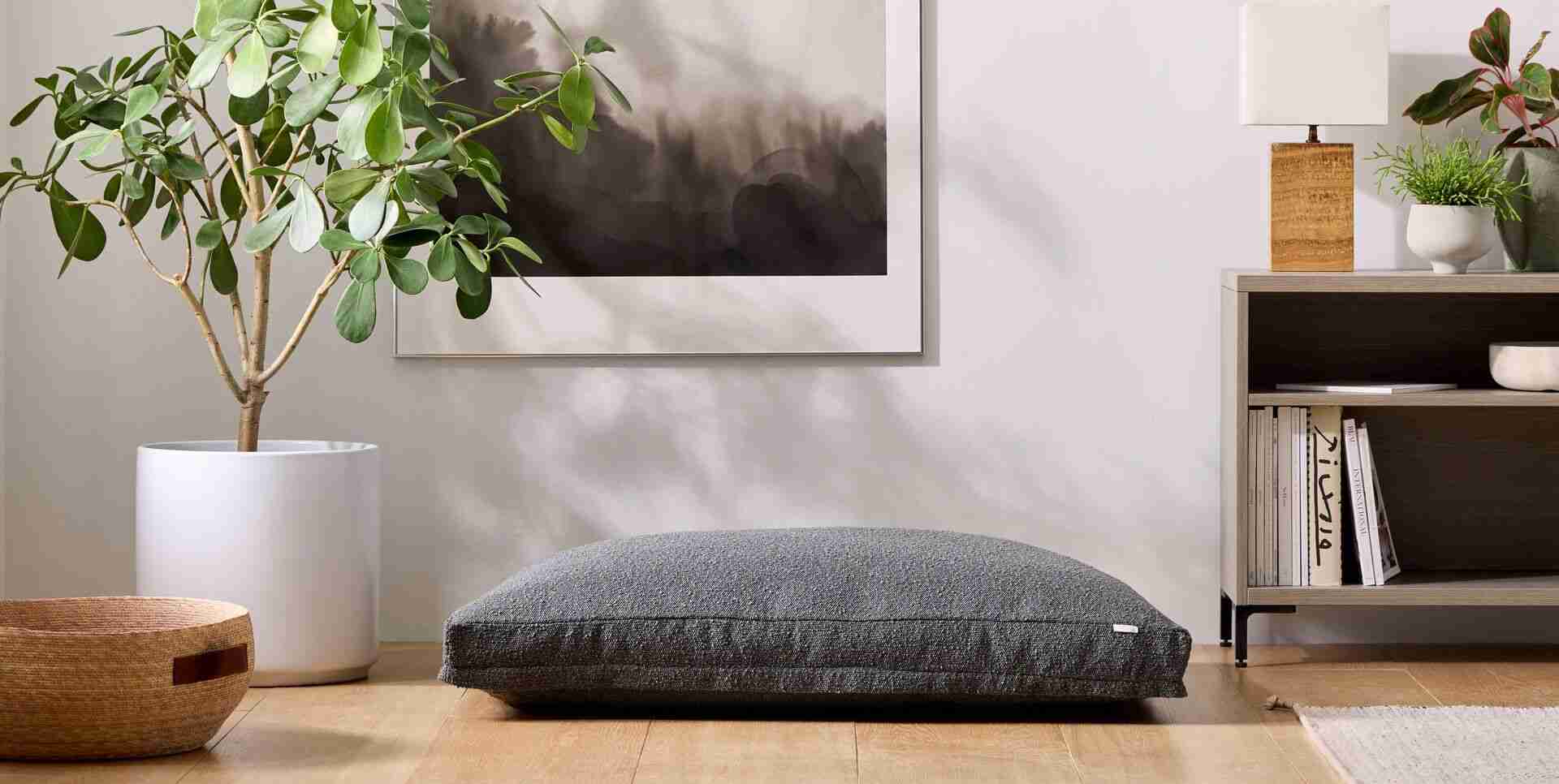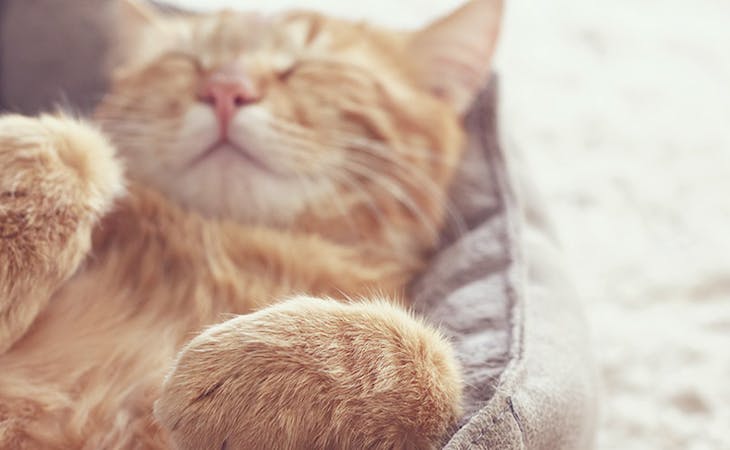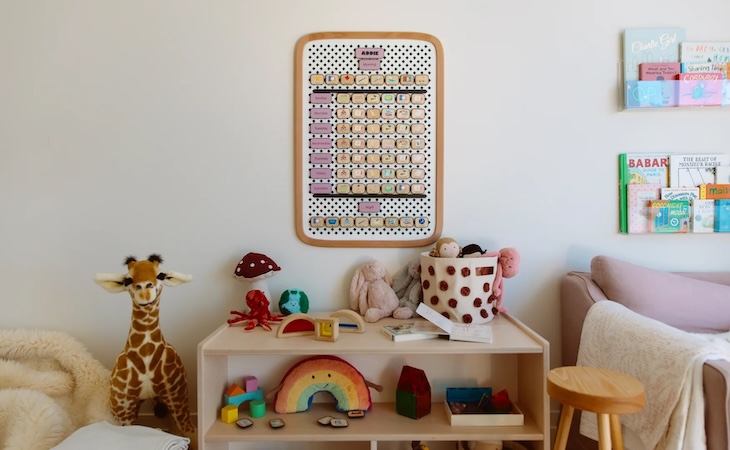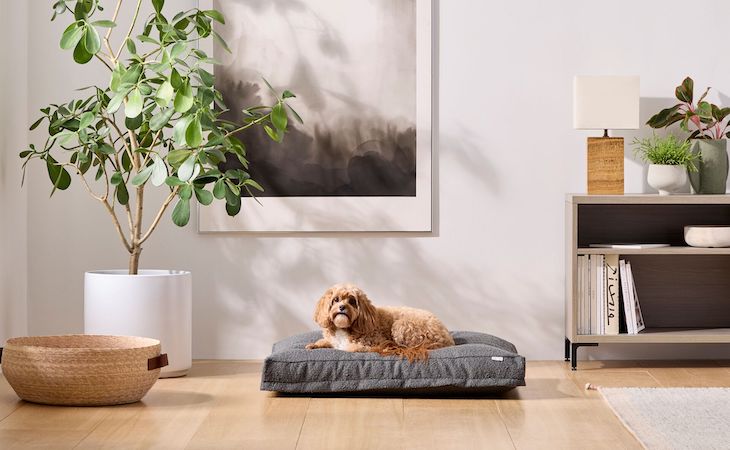Does your pet prefer to curl up on the couch, cuddle with you on your bed, or spread out in a quiet corner of the room? Regardless of where your pup or kitty likes to snooze, it’s a good idea to provide them with a bed, even if they don’t use it all the time. Experts say pets should be able to retreat to a safe, comfy place they can call their own, whether for a tranquil daytime nap or a peaceful night’s sleep.
Here, Nancy Scanlan, doctor of veterinary medicine and executive director of the American Holistic Veterinary Medical Foundation, explains the benefits of pet beds and offers some tips for how to find the best bed for your best friend.
The benefits of a pet bed
Here are the top five reasons to get a pet bed.
1. Pet beds keep animals safer
If your pet sprawls in random places for a nap—say, under the kitchen table or in front of the couch—they’re at risk of being accidentally stepped on or otherwise disturbed. But if they are trained to sleep in their own bed, you’ll always know where they are, and they won’t be surprised by the unexpected feet of passersby.
2. Pet beds boost well-being
If you slept on a hard surface or didn’t have room to stretch out, you probably wouldn’t get quality sleep. The same holds true for your pet, especially if they’re overweight, older, or arthritic. Sleeping on a tile floor or in a cramped corner can lead to inconsistent sleep and potential joint issues.
3. Pet beds protect the home environment
Buying a pet bed that you can throw in the wash, or one with a washable cover, will help keep your home free of pet hair, dander, and other debris. That’s especially important for any family members (or visitors) with allergies. “This helps with dirt tracked in from the outside, as well as potential problems with skin infections and parasites, especially fleas,” points out Scanlan. While you can vacuum upholstered furniture—or the mattress, if that’s where you pet sleeps—it’s more difficult to remove whatever they leave behind.
4. Pet beds prevent injuries
When your pet (especially if she’s a smaller breed of dog or a senior) jumps up and down on high furniture such as a bed, she’s at risk of getting hurt. A comfy bed on the floor allows for easy-in, easy-out access when they’re ready for sleep.
5. Pet beds offer a tranquil retreat
Your pet needs their own place to chill. Providing them with a comfortable spot that’s just theirs (preferably away from the clamor of the household) helps them feel calm and allows them to enjoy a bit of solitude. Plus, a pet bed is portable. If you need to move it (perhaps due to a crowded family gathering), you can temporarily put the pet bed in a quiet corner of the house to escape the noise and activity.
Related: Why does my dog sleep like that?
How to find the best pet bed
Once you decide to get a cat bed or dog bed, what should you look for when shopping? Take these factors into consideration when choosing the best bed for your canine or feline.
Pet size
How tall are they? How much do they weigh? The bigger the pet, the more room they’ll need to stretch out. You might want to measure and weigh your pet to avoid buying a too-small bed. If they’re a puppy or kitten, consider what their adult size will be when they’re all grown up.
Follow these guidelines to determine which size pet bed is right for your animal:
Pet weight Suggested bed size Dogs 1-10 pounds—or most cats XS (18” long x 13” wide) Dogs 11-25 pounds—or larger cats S (24” long x 18” wide) Dogs 26-40 pounds M (30” long x 20” wide) Dogs 41-70 pounds L (36” long x 23” wide) Dogs 71-90 pounds XL (42” long x 28” wide)
Pet preferences
“Let the pet decide their favorite type,” advises Scanlan. Most prefer raised sides, she says. Some, especially cats, like a hooded or domed bed for seclusion. What about cushioning? “Many pets prefer a smooth bed over one with chunks of filler or an egg-crate mattress,” Scanlan notes. “And most don’t like the tufted type with buttons sewn over the bed to hold filler in place.” Most pets prefer at least some padding, so opting for the cheapest, thinnest bed usually doesn’t work well, she adds.
Pet health
If your pet is dealing with any health issues, such as arthritis, they might need an orthopedic bed that provides extra cushioning and support for bones and joints. And certain breeds of animals, such as hairless cats and short-haired dogs, might get cold more easily and need extra insulation for warmth. Although you can find a variety of heated pet beds on the market, Scanlan explains that “they can be a problem if a pet chews a cord or claws into a heating pad.” Her solution? “A hot water bottle is often a better option.”
Related: The case for sleeping with dogs
Ease of cleaning
For very small beds, Scanlan finds those that are totally washable are a convenient option. For larger beds, she suggests getting one with a removable, washable cover. If possible, order an extra cover so your pet isn’t “bed-less” while you wash the cover.
Location
Plan in advance where you will place the bed. For example, “Don’t put the bed in or near a draft,” advises Scanlan. “You might not notice a draft standing up, so stoop down to check.” In general, pets like to be near their companion humans. Scanlan suggests putting one pet bed in the room with your bed and another close to your favorite chair or couch. If you plan to place the pet bed outdoors, make sure you get a well-insulated bed made of durable-but-comfortable material that resists mold and fungus.
The bottom line: Just as we believe in investing in a quality mattress, the same rule holds true for your beloved pet—even more so, as dogs and cats sleep upwards of 10 hours a day. Take the above factors into consideration and buy the best pet bed your budget allows for the health and well-being of your furry family member.
Find the best dog bed at Saatva
Saatva offers a high-quality

Saatva comfort & luxury, designed just for our furry friends
that provides excellent comfort and support for dogs. Available in three sizes (small, medium, and large), our dog bed can accommodate a wide range of breeds.
The pillow top is filled with quilted plush comfort fibers to help reduce pet dander while keeping your pet cool and comfy. The coil design prevents the bed from flattening out over time, which tends to be a common issue with fiber or foam-filled pet beds. Plus, the removable high-performance fabric cover with a gusseted design repels stains and liquids for easy spot cleaning.




